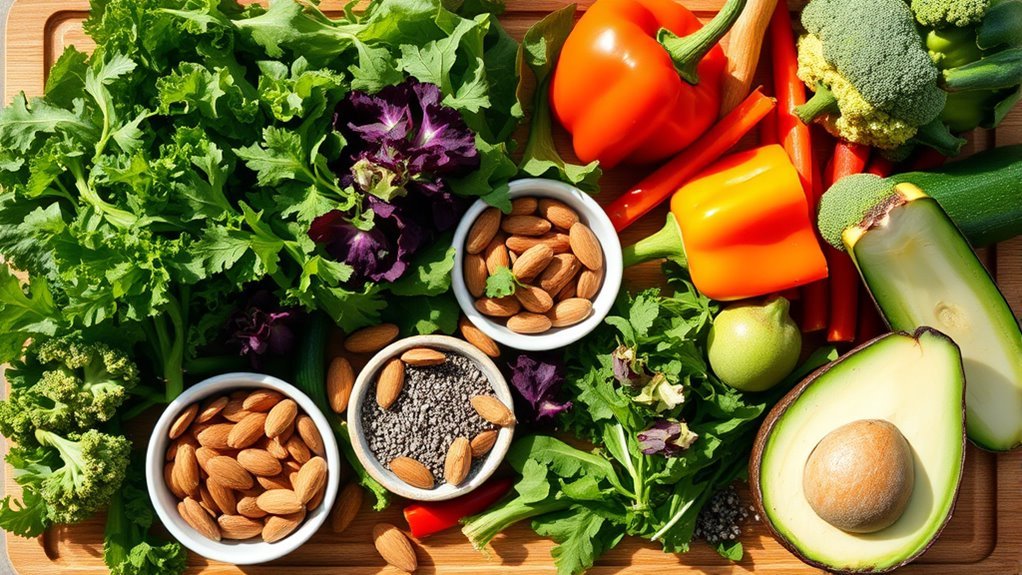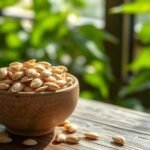To get fiber on a keto diet, focus on low-carb, high-fiber foods. Include leafy greens like spinach and kale, which are nutrient-dense. Nuts and seeds like chia and flaxseeds are also great options, providing healthy fats and fiber. Incorporate low-carb berries, such as raspberries and blackberries, for a sweet treat. You can also add psyllium husk to smoothies or recipes for an extra fiber boost. There’s plenty more to explore for enhancing your fiber intake.
Understanding Fiber and Its Importance on Keto
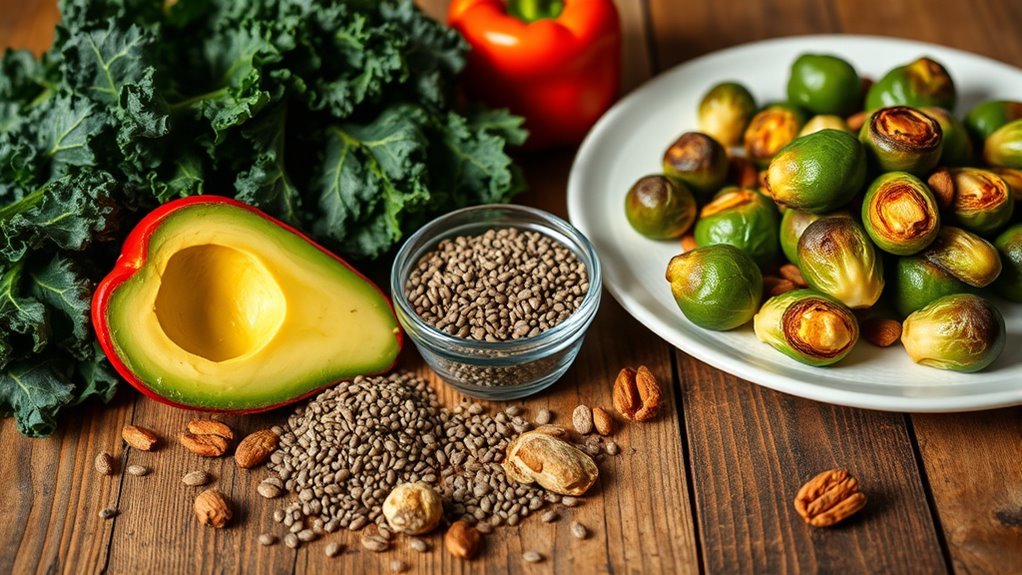
When you commence on a keto diet, understanding fiber’s role becomes essential, especially since many traditional sources of fiber, like grains and fruits, are often limited. Fiber types can be broadly categorized into soluble and insoluble fibers, both of which play a vital role in digestive health. Soluble fiber dissolves in water, helping to regulate blood sugar and cholesterol levels, while insoluble fiber adds bulk to your stool, promoting regular bowel movements. Incorporating keto-friendly fiber sources like chia seeds, flaxseeds, and avocados can help you maintain digestive balance. Additionally, consider including nutritional yeast in your meals as it is low in carbohydrates and rich in essential vitamins. Remember, adequate fiber intake not only supports your gut health but also enhances your overall well-being, ensuring you enjoy the freedom that comes with a balanced keto lifestyle.
Low-Carb Vegetables Packed With Fiber
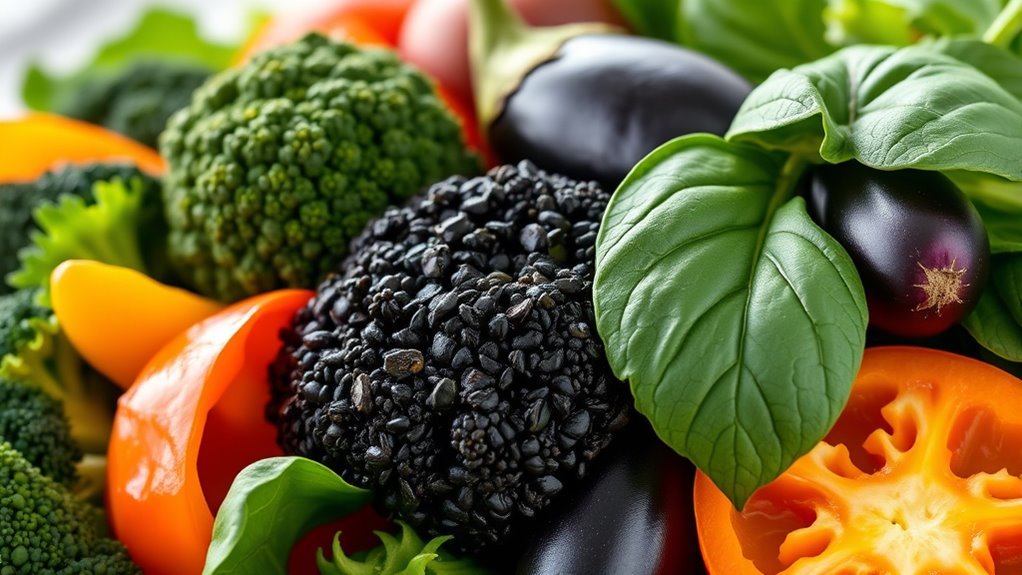
When you’re on a keto diet, choosing low-carb vegetables that are high in fiber is vital for maintaining gut health. You’ll want to focus on nutrient-dense options that not only provide fiber but also essential vitamins and minerals. Plus, incorporating some cooking tips can help you maximize flavor while keeping carbs in check. Including leafy greens in your meals can significantly enhance your fiber intake while supporting overall health.
Best Low-Carb Options
Looking for ways to incorporate fiber into your keto diet without breaking your carb limit? You’re in luck! Many low-carb vegetables are not only fiber-rich but also versatile for various meals. Spinach, kale, and broccoli are fantastic options that can easily be added to salads or stir-fries. You can also whip up fiber-rich smoothies using avocado or chia seeds, combined with your favorite low-carb fruits. For those snack cravings, consider snacking on celery sticks with cream cheese or cucumber slices topped with guacamole. These low carb snacks help keep your fiber intake up while staying within your keto guidelines. By focusing on these fiber-packed choices, you can maintain both your health and your freedom to enjoy delicious meals. Additionally, broccoli is a great choice due to its low carb count and high fiber content, making it perfect for a keto-friendly diet.
Nutrient Density Matters
While many people associate a keto diet with a focus on fats and proteins, it’s crucial to take into account the nutrient density of the foods you consume, especially when it comes to fiber. Low-carb vegetables like spinach, kale, and broccoli aren’t just low in carbs; they’re also rich in fiber quality and packed with essential nutrients. By prioritizing these nutrient sources, you can effectively boost your fiber intake while staying within your carb limits. These veggies provide necessary vitamins and minerals, enhancing your overall health. Plus, they help you feel full, making it easier to maintain your keto lifestyle. Embracing high-fiber, low-carb foods liberates you from the unwanted side effects of low fiber consumption, promoting better digestion and wellness. Incorporating cruciferous vegetables like broccoli and cauliflower further diversifies your diet while supporting overall health on a ketogenic diet.
Cooking Tips Included
To maximize your fiber intake on a keto diet, knowing how to prepare low-carb vegetables can make all the difference. Focus on fiber-rich snacks like broccoli, spinach, and zucchini. Steaming these veggies helps preserve their nutrients and enhances digestibility. You can also try sautéing them in coconut oil or olive oil for added flavor. Incorporating green beans into your meals is another excellent way to keep your fiber intake high while staying within carb limits.
Incorporating different cooking techniques, like roasting or grilling, can bring out unique tastes while keeping carb counts low. Consider blending these vegetables into smoothies or soups for a fiber boost that feels indulgent. By mastering these methods, you’ll not only enjoy delicious meals but also guarantee you’re meeting your fiber needs without sacrificing your keto lifestyle. Enjoy the freedom of diverse, satisfying meals!
Nuts and Seeds: Great Sources of Fiber
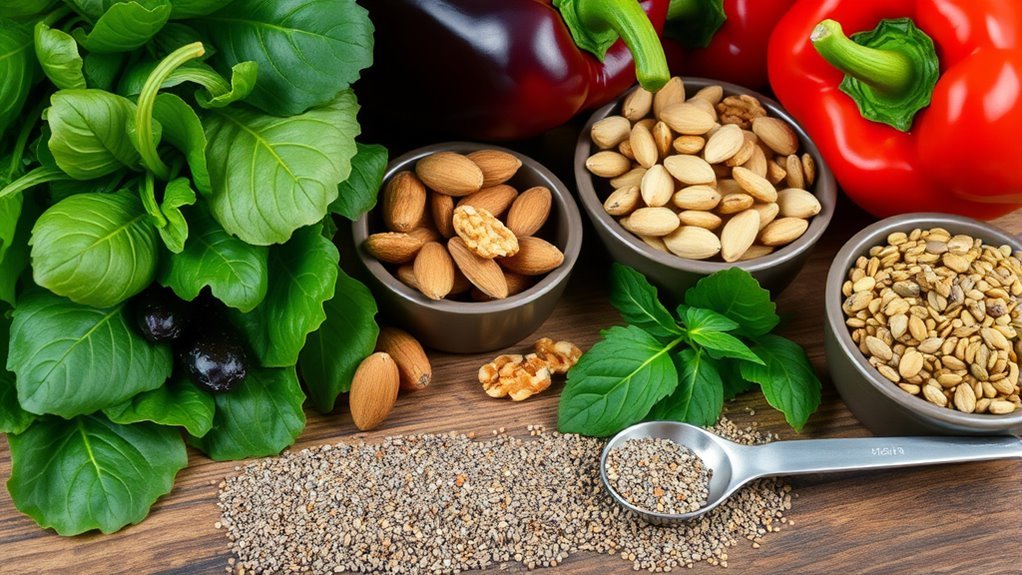
Nuts and seeds are not just tasty snacks; they’re also excellent sources of fiber, making them a perfect addition to a keto diet. By including various nut varieties and seeds, you can enhance your fiber intake while enjoying delicious flavors. Here’s a quick look at some popular choices:
| Nut/Seed | Fiber per 1 oz (28g) |
|---|---|
| Chia Seeds | 10g |
| Almonds | 3.5g |
| Pumpkin Seeds | 5g |
Incorporating these foods not only provides seed benefits like improved digestion but also keeps you feeling full longer. With a few handfuls of these nutrient-dense options, you can easily meet your fiber needs without straying from your keto goals. Additionally, they provide healthy fats that support overall health while adhering to your dietary restrictions.
Avocado: A Fiber-Rich Superfood
Avocados are not just delicious; they’re also packed with essential nutrients and fiber, making them a perfect fit for your keto diet. Incorporating avocados into your meals can enhance both flavor and health benefits. Let’s explore the various ways you can enjoy this fiber-rich superfood while staying within your carb limits. Additionally, avocados are low in carbs and high in healthy fats, which makes them an ideal choice for maintaining ketosis.
Nutritional Benefits of Avocado
While many people think of avocados as a creamy addition to their meals, they’re actually a powerhouse of nutrition, particularly when it comes to fiber content. With around 10 grams of fiber in a single avocado, you’re getting a significant boost towards your daily intake. Different avocado varieties, like Hass or Fuerte, offer varying textures and flavors, but they all pack in essential avocado nutrients, including healthy fats, potassium, and vitamins E and C. These nutrients support heart health, reduce inflammation, and promote digestive health—crucial elements for anyone following a keto diet. By incorporating avocados, you’re not just adding flavor; you’re enhancing your overall well-being while enjoying the freedom of delicious, satisfying meals. Their low-carb fruit profile makes them an ideal choice for maintaining ketosis.
Incorporating Avocado Into Meals
Incorporating avocados into your meals can effortlessly increase your fiber intake while keeping your keto diet on track. These fiber-rich fruits offer numerous avocado benefits, such as promoting healthy digestion and keeping you feeling full longer. Try adding sliced avocado to salads or blending it into smoothies for a creamy texture. You can also whip up a delicious guacamole as a dip or spread, perfect for pairing with keto-friendly veggies. Looking for quick avocado recipes? Consider avocado-stuffed eggs or using it as a topping on baked chicken. By making avocados a staple in your meals, you not only boost your fiber intake but also enjoy a versatile superfood that fits perfectly within your lifestyle. Additionally, avocados are a great source of healthy fats, which are essential for maintaining the right macronutrient balance in a keto diet.
Chia and Flaxseeds: Tiny Seeds, Big Benefits
Although many people underestimate their nutritional power, chia and flaxseeds are two of the best sources of fiber you can include in a keto diet. Chia benefits include their ability to absorb water, expanding in your stomach and promoting a feeling of fullness. This can help curb cravings while keeping your carb intake low. On the other hand, flaxseed nutrition is rich in omega-3 fatty acids and lignans, which support heart health and hormone balance. Adding these tiny seeds to smoothies, salads, or yogurt can easily boost your fiber intake. Just two tablespoons of chia or flaxseeds can provide up to 11 grams of fiber, making them a smart choice for your keto lifestyle. Additionally, chia seeds have a low glycemic index, which helps maintain stable blood sugar levels while enjoying the freedom of flavorful, fiber-rich meals!
Berries: The Best Low-Carb Fruits for Fiber
When considering low-carb fruits that can fit seamlessly into a keto diet, berries stand out as a fiber-rich option. Their low sugar content and high fiber make them perfect for your nutritional needs. Here are three berry varieties you should incorporate into your diet:
- Raspberries: With about 8 grams of fiber per cup, they’re a delicious way to boost your intake.
- Blackberries: These offer around 7 grams of fiber per cup, making them a satisfying snack.
- Strawberries: Containing about 3 grams of fiber per cup, they’re versatile for smoothies or salads.
Including these berries not only enhances your fiber content but also keeps your carb count low, allowing you to enjoy a tasty and fulfilling keto experience.
Incorporating Psyllium Husk Into Your Diet
Psyllium husk is a fantastic addition to your keto diet, especially if you’re looking to increase your fiber intake without adding too many carbs. This natural fiber supplement offers numerous psyllium benefits, such as promoting digestive health and aiding in regularity. You can easily incorporate it into your meals by adding it to smoothies, yogurt, or even baking low-carb bread.
For some delicious psyllium recipes, try mixing it into almond flour pancakes or using it as a thickener in soups. Just remember to drink plenty of water when consuming psyllium, as it absorbs liquid and expands in your stomach. By integrating this versatile ingredient, you’ll not only enhance your fiber intake but also enjoy greater freedom in your keto culinary creations.
Keto-Friendly Fiber Supplements
In addition to incorporating psyllium husk, there are several other keto-friendly fiber supplements that can help you meet your fiber needs while maintaining a low-carb lifestyle. These fiber supplements not only support digestive health but also keep you feeling full and satisfied.
Explore keto-friendly fiber supplements to enhance digestive health and keep you feeling satisfied while staying low-carb.
Here are three options to evaluate:
- Chia Seeds: Packed with fiber and omega-3s, these tiny seeds expand in water, promoting fullness.
- Flaxseed Meal: This ground seed is rich in both soluble and insoluble fiber, enhancing digestive regularity.
- Inulin: A prebiotic fiber derived from chicory root, inulin supports gut health and can be easily added to smoothies or baked goods.
Creative Recipes to Boost Fiber Intake on Keto
While many people think a keto diet limits fiber intake, there are plenty of creative ways to incorporate high-fiber ingredients into your meals. Start your day with keto fiber smoothies, blending spinach, avocado, and chia seeds for a nutritious, satisfying boost. For lunch or dinner, whip up fiber-rich soups using ingredients like zucchini, mushrooms, and cauliflower. These veggies not only enhance fiber content but are also low in carbs. You can also experiment with flaxseed meal in baked goods or sprinkle it on salads for added crunch. Don’t forget about nuts and seeds, which are excellent for snacking while keeping your fiber levels up. Enjoy the freedom of delicious, fiber-packed meals on your keto journey!
Frequently Asked Questions
Can I Get Enough Fiber on a Strict Keto Diet?
Sure, you can get enough fiber on a strict keto diet—if you’re okay with a little irony. While many think fiber’s a carb enemy, keto fiber sources like avocados, chia seeds, and leafy greens can fit in perfectly. If you’re struggling, fiber supplementation options like psyllium husk or inulin can help too. Just remember, balancing fiber while enjoying your freedom on keto is totally possible; it just takes some creativity!
What Are the Symptoms of Low Fiber Intake on Keto?
If you’re experiencing low fiber intake on keto, you might notice symptoms like constipation, bloating, and digestive discomfort. These issues can hinder your digestive health and lead to sluggishness. To achieve constipation relief, consider adding low-carb, fiber-rich foods like avocados, chia seeds, or leafy greens to your meals. Staying hydrated and incorporating these foods can help you maintain a balanced diet while enjoying the freedom of your keto lifestyle.
How Does Fiber Affect Ketosis?
Fiber plays an essential role in maintaining keto balance. Think of it as the unsung hero in your diet; it aids in fiber digestion and helps regulate blood sugar levels. By keeping your digestive system running smoothly, fiber prevents constipation, which can sometimes occur on keto. While you’re enjoying freedom from carbs, don’t overlook fiber’s importance. It supports overall health, allowing you to thrive in your low-carb lifestyle without sacrificing well-being.
Are There Any Fiber Sources to Avoid on Keto?
Yes, there are fiber sources you should avoid on keto. High-carb vegetables like potatoes, corn, and peas can hinder your ketosis. Instead, focus on low-carb keto vegetables, such as spinach, kale, and broccoli, which provide fiber without spiking your carb intake. Also, steer clear of grains and legumes, as they tend to be high in carbs. Prioritizing these low-carb options will help you maintain your keto lifestyle while still getting enough fiber.
How Can I Track My Fiber Intake on a Keto Diet?
To track your fiber intake on a keto diet, consider using fiber tracking features in popular keto apps like MyFitnessPal or Carb Manager. These apps let you log your meals and see the fiber content of various foods, helping you stay informed. You can easily adjust your meal plans based on your fiber goals, ensuring you maintain that perfect balance without feeling restricted. Enjoy the freedom of customizing your diet while meeting your nutritional needs!
